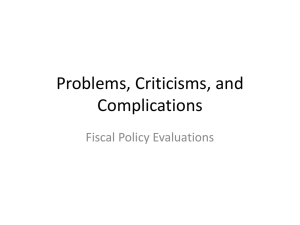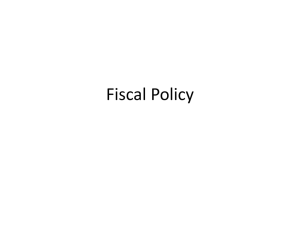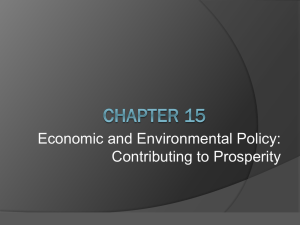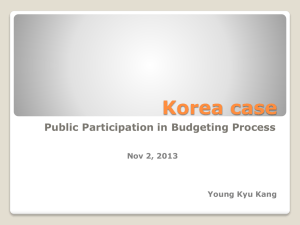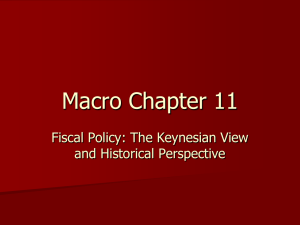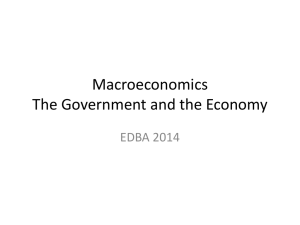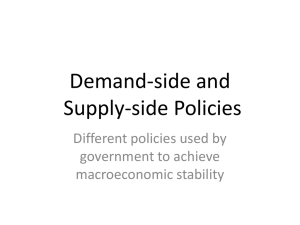Macroeconomic Policy and the AD/AS Model
advertisement
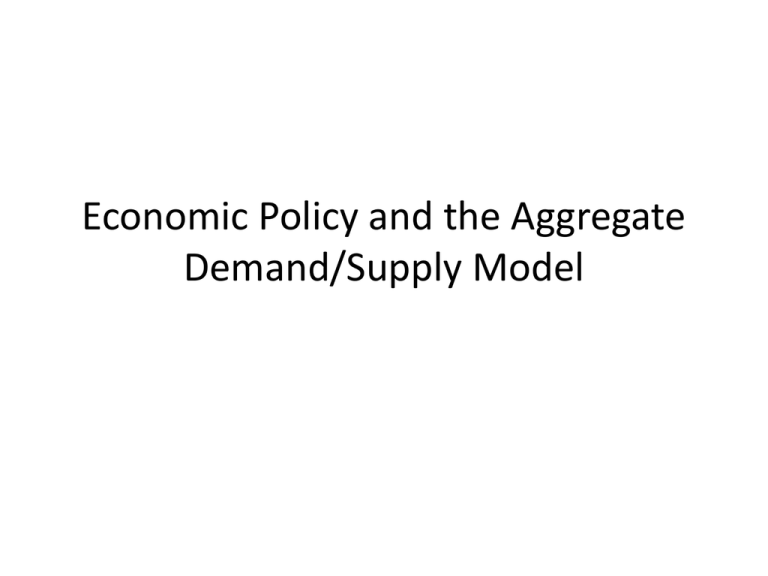
Economic Policy and the Aggregate Demand/Supply Model Macroeconomic Policy • A. Policy in the Face of Demand Shocks • B. Responding to Supply Shocks Fiscal Policy – The Basics • A. Taxes, Purchases of Goods and Services, Government Transfers, and Borrowing • B. The Government Budget and Total Spending • C. Expansionary and Contractionary Fiscal Policy • A Cautionary Note: Lags in Fiscal Policy Macroeconomic Policy • The Long-Run adjustment back to Yp may take a long time so most economists believe that the government can help expedite the return to full employment and stable prices. • Stabilization Policy: The use of government policy to reduce the severity of recessions and rein in excessively strong expansions. Macroeconomic Policy • A. Policy in the Face of Demand Shocks – Negative demand shock causes a recessionary gap. – The price level falls, but so does real GDP. – Unemployment becomes a problem – Government policy (both Fiscal and monetary) is designed to reverse this decline in AD. – This shortens the duration of a recession. Macroeconomic Policy – Positive demand shocks cause an inflationary gap. – The price level rises and so does real GDP. – Unemployment falls, but I inflation is the real problem – Again, government policy would be geared toward reversing the increase in AD – This shortens the duration of an inflationary period. Macroeconomic Policy • Responding to Supply Shocks – There is very little policy makers can do to reverse a supply shock – It is much easier to affect spending (through AD) than it is to affect production (through AS) – What if we tackled a negative supply shock by trying to influence AD? Macroeconomic Policy • Negative Supply Shocks – Suppose policy makers wanted to shift aD to the right to fight unemployment. – This would worsen the inflation. – Or suppose policy makers wanted to shift AD to the left to fight the inflation. – That would only worsen the unemployment – There are no good options here. Fiscal Policy – The Basics • A Key understanding to fiscal policy is to understand its origins. • Fiscal policy is all about taxation and government spending. • The President proposes a budget to Congress that includes plans for spending and tax collection. • Eventually Congress will amend and approve a budget and it becomes law. – This fundamentally differs from monetary policy which is created by the Federal Reserve, the central bank of the U.S. Fiscal Policy – The Basics • Taxes, Purchases of Goods and Services, Government Transfers, and Borrowing – The government plays a sizeable role in the circular flow diagram • Government Spending – Like households, the government spends money on goods and services. • What are examples of goods and services purchased by the government? Fiscal Policy – The Basics • Local: police cars in your city • State: A system of State Parks • Federal: The Military Fiscal Policy – The Basics • Transfer Payments – The government also provides transfer payments to some households. – Examples of transfer payments: • • • • • • Social Security Medicare Medicaid VA benefits, Food Stamps Etc. Fiscal Policy – The Basics • Tax Collection – Like households, the government must collect money in order to pay for this spending. – The Government Collects Taxes – What are some taxes that you or your parents pay? Fiscal Policy – The Basics • • • • • • • • Tax Collection (cont.) Sales tax Income tax Property tax Vehicle registration tax Gas Excise taxes (on liquor or tobacco) Tax on corporate profits (dividends) Fiscal Policy – The Basics • Like households, the government can borrow to make up for a shortfall in tax revenue that does not pay for all of the spending. • Government borrowing will be covered in future sections of the course. Government Budget and Total Spending • How does the government affect AD? • Remember, if we add up all of the spending in an economy we get: – C+I+G+(X-M) – G: government purchases of goods and services • This directly affects GDP and thus AD Government Budget and Total Spending • Indirectly, the government can influence consumption spending ( C) through taxes and transfers. • Look at what goes into consumption spending: – A person receives income Y from his/her job – Taxes are paid to the government and sometimes transfer payments are received by the government. – What is left over is disposable income Yd – Disposable income can now either be consumed or saved – Yd = Y – taxes = C + S or – C = Yd – S • Remember, when Yd increases, so does C Government Budget and Total Spending • So the government can indirectly increase C if it can increase Yd • How can it increase Yd? – By cutting taxes or by increasing transfer payments – The government can affect investment spending (I) through tax policy Expansionary and Contractionary Fiscal Policy • (Two short-run states of an economy – recessionary gap and an inflationary gap • Recessionary GAP - fiscal policy should try to shift AD to the right – Expansionary Fiscal Policy normally takes one of three forms: • An increase in government purchases of goods and services • A cut in taxes • An increase in government transfers Expansionary and Contractionary Fiscal Policy • Inflationary Gap – Fiscal policy should try to shift AD to the left. • Contractionary fiscal policy, normally takes one of three forms: – A decrease in government purchases of goods and services – An increase in taxes – A decrease in government transfers A Cautionary Note: Lags in Fiscal Policy • Fiscal policy looks easy but in reality it is more difficult because there are important time lags in its use. • Recognition Lag: The government has to realize that the recessionary gap exists because economic date takes time to collect and analyze, and • Recessions are often recognized only months after they have begun. A Cautionary Note: Lags in Fiscal Policy • Decision Lag: The government has to develop a spending plan, which can itself take months, particularly if politicians take time debating how the money should be spent and passing legislation. • Implementation Lag: It takes time to spend money. • For example, a road construction project begins with activities such as surveying that don’t involve spending large sums. • It may be quite some time before the big spending begins. • By this time, the economy might have already begun self-correcting back to Yp. In-Class Activities • Practice Questions: 1. The economy is currently experiencing a recessionary gap. – List two fiscal policy options that would move the economy closer to potential real GDP – Describe how your policy would achieve the desired result 2. The economy is currently at a level of output that exceeds potential GDP (Yp). – List two fiscal policy options that would move the economy closer to potential real GDP. – Describe how your policy would achieve the desired result.

